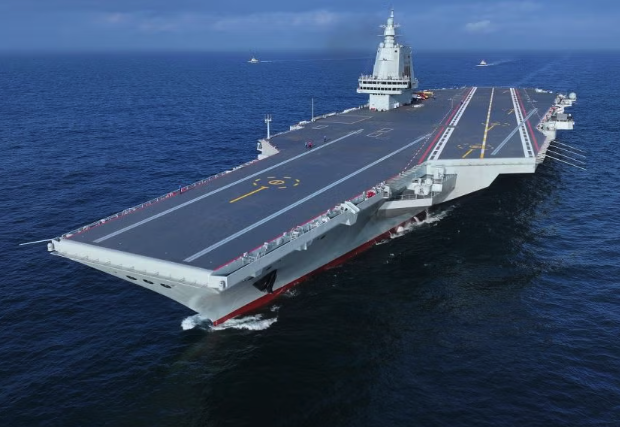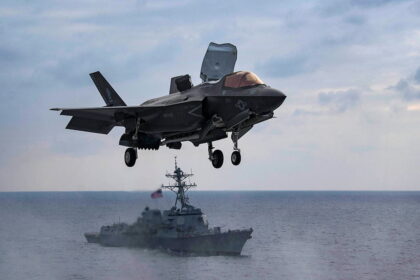China is reportedly constructing its fourth aircraft carrier at a shipyard in Dalian, even as its third and most advanced carrier, Fujian, nears commissioning after successful sea trials. According to satellite images published by the South China Morning Post, the new vessel may feature nuclear propulsion and advanced launch systems, signaling Beijing’s growing naval ambitions and drive to match U.S. maritime power in the Indo-Pacific.
BEIJING / Dalian, Oct 2025 – China appears to be stepping up its naval ambitions with reports that it is already working on its fourth aircraft carrier, even as its third carrier, Fujian, completes sea trials and approaches formal commissioning. Satellite imagery, defense-industry analysis, and official announcements point toward a major leap forward in China’s blue-water naval capabilities.
Construction of Fourth Carrier Under Way
According to a South China Morning Post report, new hull sections consistent with an aircraft carrier under construction have been observed at a shipyard in Dalian, Liaoning province. South China Morning Post The images show sections that were not present in earlier imagery, indicating active progress on what is widely believed to be Type 004, China’s next generation carrier. South China Morning Post+1
While Beijing has not officially confirmed the project, analysts interpret the presence of large modular hull components—including what may be catapult or structural segments—as strong evidence that work is underway. internationaldefenceanalysis.com+1
Marine Insight also notes that the “Type 004 is expected to follow China’s third aircraft carrier,” which is nearing the end of its trials. Marine Insight Economictimes similarly reported that construction in Dalian is proceeding as China prepares to launch Fujian. The Economic Times
Fujian: China’s Most Advanced Carrier Nears Entry into Service
Meanwhile, official and semi-official sources confirm that China’s third aircraft carrier, Fujian (Type 003), has undergone extensive trials and is in its final phases before commissioning.
- The Fujian has been conducting sea trials since May 2024. Reuters+2South China Morning Post+2
- In September 2025, China released images and video showing catapult-assisted takeoffs and arrested landings (CATOBAR) of carrier aircraft including the J-15T, J-35, and KJ-600 from its deck, suggesting the carrier has achieved a level of operational capability. South China Morning Post+3Breaking Defense+3Wikipedia+3
- The military described these tests as contributing to “preliminary full-deck operational capability,” laying the foundation for integrating the air wing and carrier battle group. Breaking Defense+1
- The Fujian, unlike China’s first two carriers (Liaoning, Shandong), is designed with electromagnetic aircraft launch systems (EMALS or variants thereof), a more advanced technology than the traditional ski-jump launch method. Wikipedia+3Breaking Defense+3South China Morning Post+3
These recent tests mark a crucial milestone: China demonstrating not only the hardware but also the operational techniques required for modern carrier operations. Breaking Defense+2Wikipedia+2
What to Expect from the Fourth Carrier
Based on expert analysis and media reports, here are some of the expected characteristics and strategic implications of China’s fourth carrier:
| Feature | Possible Speculation / Reporting |
|---|---|
| Name / Class | Commonly referred to as Type 004 or a “004-class” supercarrier. Agenzia Nova+3Wikipedia+3internationaldefenceanalysis.com+3 |
| Propulsion | Some reports suggest it may adopt nuclear propulsion, which would allow extended endurance and operational reach without frequent refueling. internationaldefenceanalysis.com+3India Today+3The Economic Times+3 |
| Launch Systems | It is expected to use electromagnetic catapults and arrested landing systems similarly to Fujian (CATOBAR) to launch more advanced and heavier aircraft. Agenzia Nova+3Wikipedia+3internationaldefenceanalysis.com+3 |
| Scale / Displacement | Analysts speculate it may be significantly larger than current carriers, possibly rivaling or exceeding some U.S. designs. National Security Journal+2Wikipedia+2 |
| Timeline | The project is believed to have begun assembly in 2024, with more hull segments observed also in mid-2025. South China Morning Post+2internationaldefenceanalysis.com+2 |
If nuclear propulsion and larger displacement are confirmed, the Type 004 could mark China’s entrance into the realm of supercarriers, joining a small number of navies capable of global power projection.
Strategic and Regional Implications
China’s incremental carrier build-up is part of a broader ambition to transform the People’s Liberation Army Navy (PLAN) into a genuine blue-water force capable of sustained operations beyond its near seas.
- Power Projection: A fourth carrier—especially nuclear-powered—would allow China to deploy fleets farther from its shores, influencing strategic corridors in the Indo-Pacific, Indian Ocean, and beyond.
- Operational Redundancy: More carriers can support simultaneous missions, reduce pressure on individual ships, and improve maintenance cycles.
- Technology Validation: The success of the EMALS-based Fujian is a testbed for future carriers. If the system proves reliable under realistic operational conditions, China could close the technological gap with leading navies.
- Naval Competition: This program will inevitably be viewed as part of the maritime competition between China and other naval powers, especially the United States and its allies.
Cautions and Uncertainties
Despite the promising indicators, several caveats remain:
- Official Silence: Chinese authorities have not publicly confirmed many of the reports. The government’s policy has been to reference only broad “assessments” tied to national security when asked about future carriers. South China Morning Post+1
- Technical Challenges: Nuclear propulsion and scale-up of carrier systems are notoriously complex. Integrating reactors, advanced electronics, and catapult systems is a difficult engineering challenge with high risk.
- Operational Maturity: China’s carrier operations are still maturing. Time, training, and real-world testing will determine how effectively the carriers can be used.
- Timeline Unclear: While hull construction is underway, full commissioning could take several more years depending on testing, outfitting, and sea trials.





